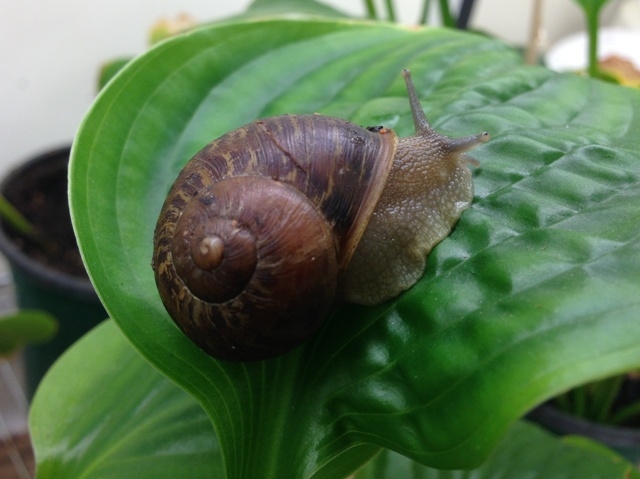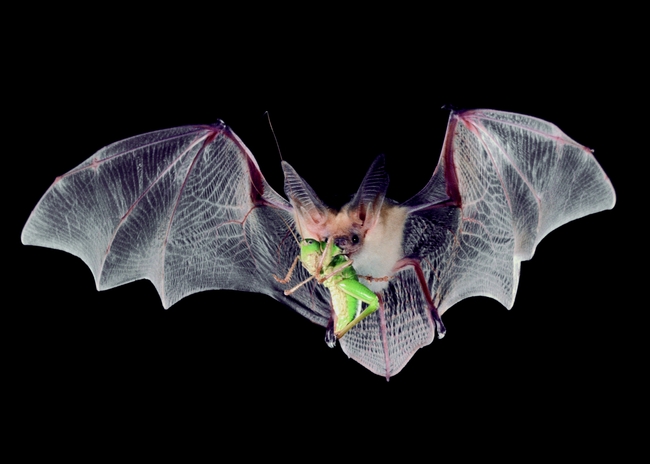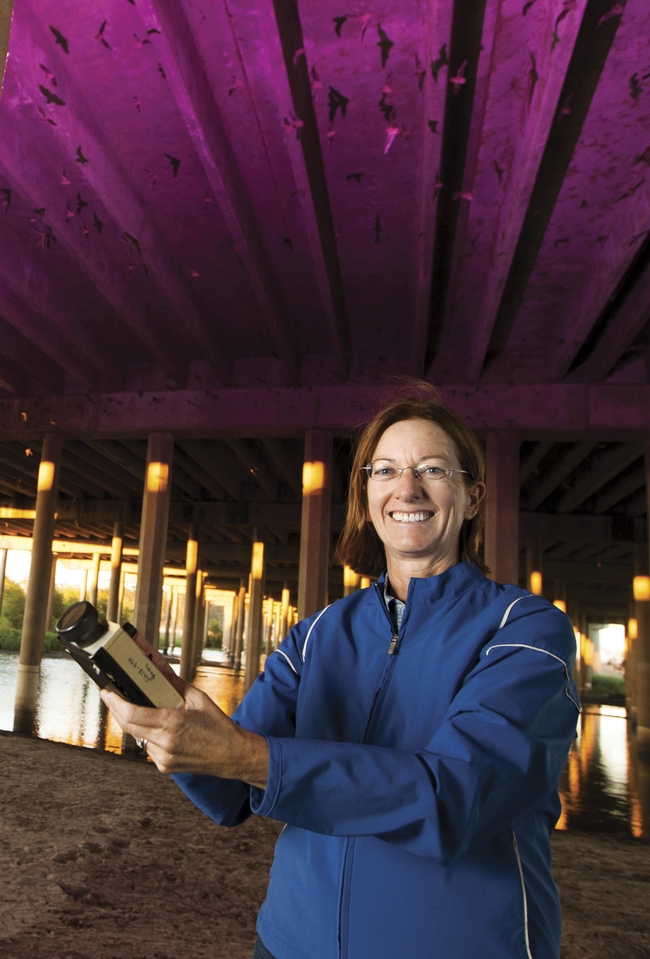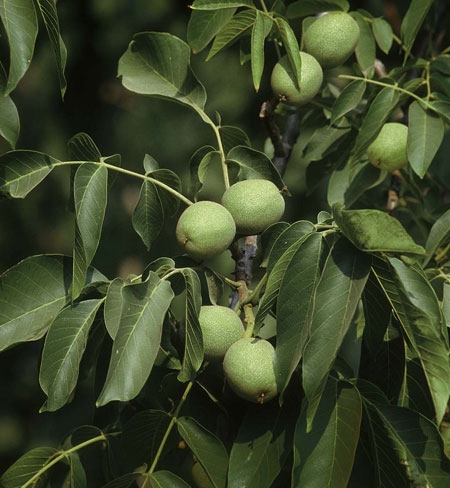Posts Tagged: bats
Non-native snails introduced by French for escargot
Approximately 280 species of snails and slugs are found in California; 242 are thought to be native. The vast majority of the native species are not considered to be pests of nurseries or other production systems.
The most damaging snails and slugs are those that have been accidentally or purposely introduced from areas outside of the US. Most of California's pest gastropods are European species.
Other news:
The Chico News & Review published a profile of local UC ANR Cooperative Extension farm advsior Dani Lightle. Lightle works with Glenn County growers of walnuts, almonds, prunes, olives, pistachios, pecans and fruit. “Basically, if it grows on a tree, it comes my way,” said Lightle, referring to the calls she receives at her Orland office. The article provided background information about UC Cooperative Extension and ANR. "The system's purpose was to be a bridge between public universities and the general public," the article says.
The news website Ensia.com reported on research underway in Northern California on the role of bats in orchard pest control. An intern, under the guidance of UC ANR farm advisor Rachael Long, is comparing orchards with nearby bat boxes with orchards that do not have the convenient dwellings for the flying rodents. "If you increase diversity by relying on insects, bats, raptors, etc., you help strengthen your farming system," Long said.
Bats save walnut growers money on pest control
Bats prey on insects and can consume as much as their body weight in insects per night. Rachael Long, UC ANR Cooperative Extension farm advisor, discussed how bats protect walnut orchards with Capital Public Radio show Insight host Beth Ruyak. Long's research has found that each bat provides about $10 worth of pest control savings for walnut growers.
California farmers produce most of the nation's walnuts, about 500,000 tons of walnuts on 290,000 acres, with an annual crop value of $1.8 billion.
Long, who works on field crops and pest control in Yolo, Sacramento and Solano counties, noted there are 250,000 bats living under the Yolo Causeway alone that could be employed for pest control.
When asked how she knows that the nocturnal animals are eating the damaging pests, Long explained that she examines the guano to identify the insects they've eaten. "Bats have very shiny poop," she said, because their fecal matter is full of insect exoskeletons.
Long, who has studied the design elements of bat houses, brought a sample of a bat house to the studio. She said the box should be placed in an area that gets afternoon shade and at least 10 feet off the ground to protect the bats from cats and dogs.
Long also talked about the Black Rock Desert trilogy, a series of educational children's books about the adventures of a boy and a pallid bat that she has authored.
For more information about Long's bat project, see her blog post Bats in the belfry? No, bats in walnut orchards.
Long will be discussing her bat research with the Capital Science Communicators group tonight at G Street Wunderbar in Davis. She will bring specimens of common bat species for people to see and touch. The talk is part of UC Davis' Science Café series and is a free event that's open to the public.
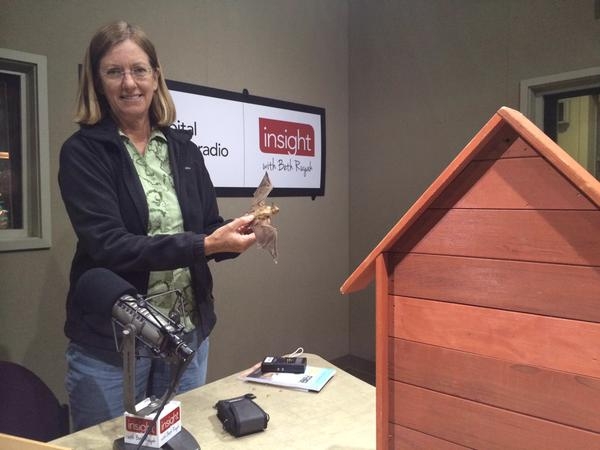
Rachael Long shows a bat and bat box.
Bats in the belfry? No, bats in walnut orchards
Bats are voracious predators of night-flying insects that target California crops. Research statistics show that a pregnant or nursing female can consume as much as two-thirds of her body weight in insects per night. That's somewhat like a 150-pound man eating 100 pounds of food per day.
What's the economic value of bats to the agricultural pest control? It probably exceeds $23 billion per year, according to recent studies. However, very little data exists on the benefits of bats for individual crops, such as walnuts.
UC Agriculture and Natural Resources researchers, together with UC Davis, are launching a survey to better understand the value of bats (and birds) on managed lands. The voluntary survey, focused on growers and landowners in California's Central Valley, may be completed online.
Work is already underway to assess the pest-control impact of bats on walnut production in the Central Valley with a grant from the U.S. Environmental Protection Agency STAR (Science to Achieve Results).
California produces almost all of the nation's walnuts. Farmers grow some 500,000 tons of walnuts on 290,000 acres, with the annual crop valued at $1.8 billion. Due to popular demand, new orchards are planted every year, calling for more intensive farming practices to manage costly crop pests. For walnuts, the key pest is the codling moth, a larva that feeds on developing nuts. The adult moths begin to fly and lay eggs on the nutlets in May and produce up to four generations per year.
Growers, as part of their pest control management practices, typically use insecticides, spraying once or twice a year for this pest. Many also use pheromones, a mating-disruption technology that prevents males from finding females. Although generally effective, pesticides are expensive and they can have harmful impacts on the environment.
Bats forage in walnut orchards for codling moths and other insects. Colonies of bats double their activity on farms when they roost in bat houses attached to barns in the orchards. The Mexican free-tailed bat is the most abundant species, followed by the Yuma and California myotis, and five other species, including the pallid bat.
In an effort to quantify the economic impact of bats' consumption of codling moths, we captured 36 Mexican free-tailed bats over a three-night period in an 80-acre walnut orchard in Yolo County. Some 3,000 bats live in the bat houses in an abandoned shop on the property.
The research procedure: We opened our mist net from 11 p.m. to 2 a.m. to correspond with codling moth flights and bat activity, and captured the bats as they returned to the roost after feeding. We placed the bats individually in sterile cloth sacks and kept them there until they defecated, then we released them. We quickly froze the guano pellets and shipped them to a USDA lab, where scientists genetically tested them for the presence of codling moths.
Our preliminary data suggest that 5 percent of these bats – about 150 bats from this colony of 3,000 – consumed at least one codling moth per night. We calculated 30 nights per generation for the codling moth, and four generations per year, with each female moth laying 60 viable eggs on individual nuts.
For a typical 80-acre walnut orchard producing a total of 136 tons of walnuts per year, we estimate that bats can protect about 6 percent of the crop yield, or $29,700 worth of walnuts per season at the current price of $1.65 per pound. That's an economic value of $10 per bat per year. And that figure probably underestimates the true value, since for some species of bats, up to 40 percent of their diet can consist of moths – an average of about 15 moths per night.
The next steps: we are refining our economic data and determining whether these insect-hunting bats help reduce pesticide use in walnut orchards.
Bats provide these pest control services for free while farmers enjoy a decrease of pests in their orchards and an increase in profits.
Co-authors: Rachael Long, UC ANR advisor; and Katherine Ingram, Department of Wildlife, Fish and Conservation Biology, UC Davis.
What Bees, Butterflies, Beetles, Birds and Bats Have in Common
Bees do it. Butterflies do it. Beetles do it. Birds do it. Bats do it. Do what, you ask? They pollinate! The Bohart Museum of Entomology at the...
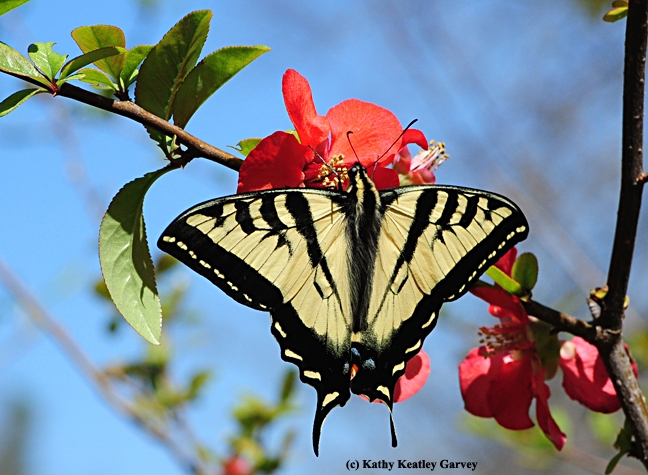
A Western tiger swallowtail, Papilio rutulus, visiting a flowering quince in the UC Davis Arboretum. Butterflies are pollinators. (Photo by Kathy Keatley Garvey)
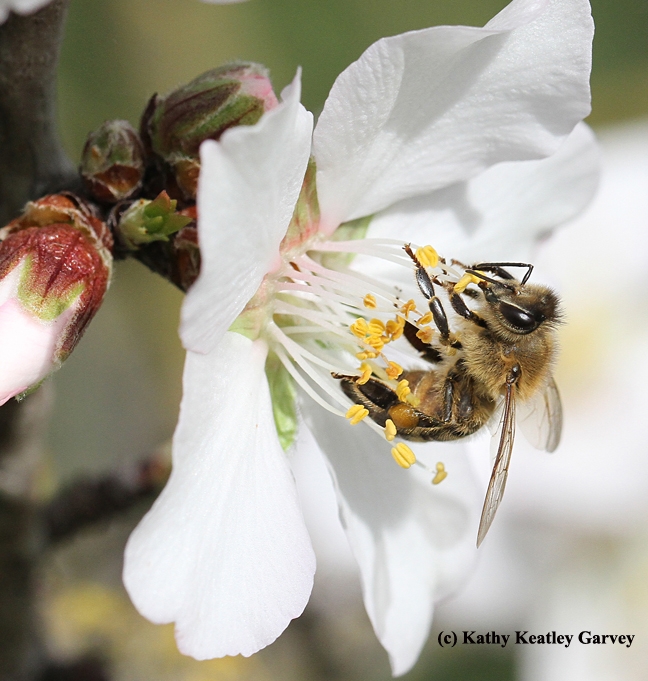
A honey bee pollinating an almond blossom. (Photo by Kathy Keatley Garvey)
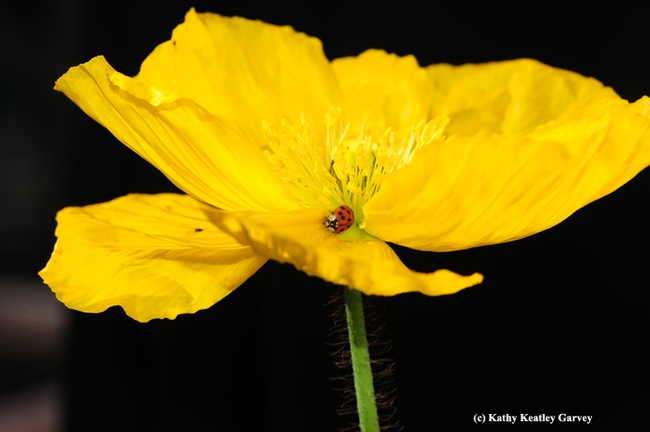
A lady beetle pollinating an Iceland poppy. (Photo by Kathy Keatley Garvey)
Curious About Bats?
Curious about those insect-eating bats? Yolo County Farm Advisor Rachael Freeman Long, who has been researching and writing about bats for 20 years,...

Rachael Long (left) and Corky Quirk talk about bats at an educational program at the Avid Reader, Davis. Quirk is holding a bat that's feeding on a mealworm. (Photo by Kathy Keatley Garvey)
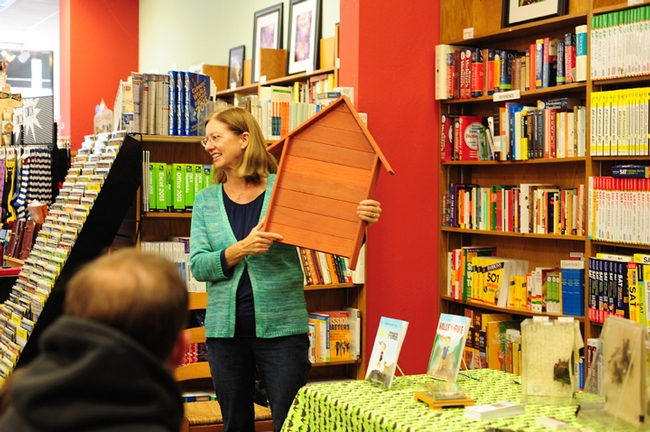
Rachael Long displays a bat house made by her friend Ben Frey of Hopland. (Photo by Kathy Keatley Garvey)


